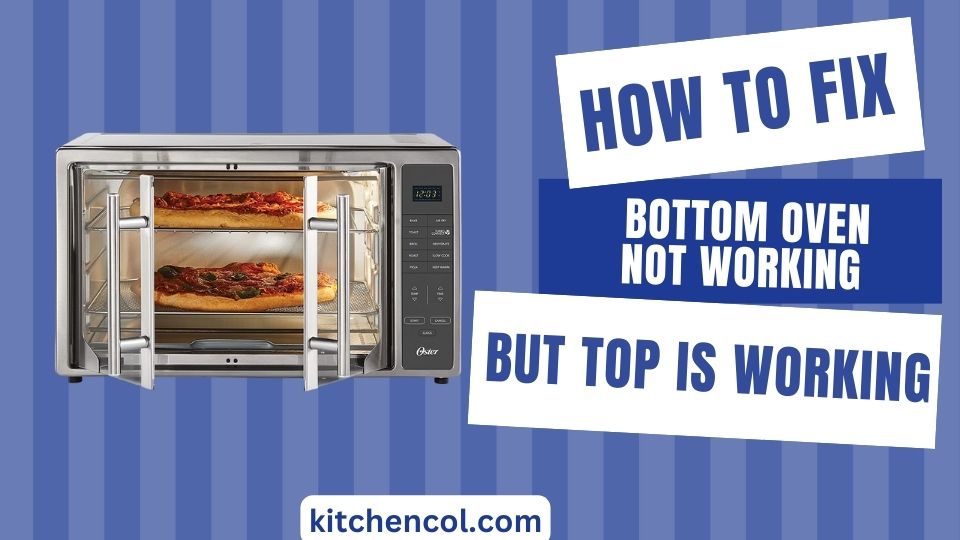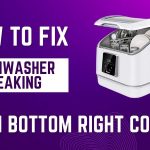Having a malfunctioning oven can be a frustrating experience, especially when it’s the bottom oven that’s not working while the top one is. The bottom oven is typically used for baking larger items, roasting meats, or cooking multiple dishes at once, making it an essential part of a fully functional kitchen. If you’re experiencing this issue, don’t worry – there are several common causes and solutions that can help you troubleshoot and fix the problem.
In this article, we’ll go over the most common causes of a bottom oven not working and provide step-by-step instructions on how to diagnose and repair the issue. Whether you’re a seasoned DIYer or a novice, we hope this article will help you get your oven back in working order.
Common Causes of a Bottom Oven Not Working
There are several reasons why a bottom oven might not be working while the top one is. These are a few of the most typical causes:
Faulty heating element:
The heating element in the bottom oven can burn out over time, making it unable to heat up. This is one of the most common causes of a bottom oven not working.
Broken thermostat:
The thermostat in the bottom oven regulates the temperature and can become damaged or inaccurate, causing the oven to not heat up or heat up too much.

Malfunctioning igniter:
In a gas oven, the igniter lights the gas and starts the heating process. If it’s not functioning properly, the oven won’t heat up.
Blown fuse:
The oven has a fuse that can blow if there’s an electrical surge or other issues. If the fuse is blown, the oven won’t heat up.
Control board issues:
The control board is the computer that regulates the oven’s functions. If it malfunctions, it can cause the oven to not heat up or heat up too much.
Wiring problems:
The wiring in the oven can become damaged or loose, causing the oven to not heat up or heat up unevenly.
It’s important to note that some of these issues can be dangerous, especially if you’re dealing with gas. Always exercise caution and follow proper safety protocols when diagnosing and repairing your oven.
How to Troubleshoot and Fix the Issue
If you’re experiencing a bottom oven not working, here are some steps you can take to troubleshoot and fix the issue:
Check the power supply:
Make sure the oven is plugged in and that the circuit breaker hasn’t been tripped. If the oven has a gas supply, make sure the gas valve is turned on.
Inspect the heating element:
Locate the oven’s heating element there, and physically check it for any signs of wear and tear like breaks or cracks.
If you see any damage, replace the heating element.
Test the heating element:
Use a multimeter to test the heating element’s resistance. If the resistance is too high or too low, the element is faulty and needs to be replaced.
Check the thermostat:
Check the operation of the thermostat with a multimeter. If it’s not, replace the thermostat.
Inspect the igniter:
In a gas oven, the igniter should glow bright orange when it’s working properly. If it doesn’t, replace the igniter.
Test the fuse:
Use a multimeter to test the oven’s fuse. If it’s blown, replace the fuse.
Check the control board:
If the oven still isn’t working after checking the heating element, thermostat, igniter, and fuse, it may be an issue with the control board. Consult the oven’s manual for instructions on how to test and replace the control board.
Check the wiring:
If none of the above steps have fixed the issue, it may be a problem with the wiring. Check the wiring for any signs of damage or loose connections. If you’re not comfortable working with electrical wiring, call a professional.
Always make sure to turn off the power supply to the oven before attempting any repairs. If you’re not comfortable working with gas or electrical components, or if you’re unsure about what to do, it’s best to call a professional for help.
Future Maintenance Tips
To help prevent a bottom oven not working in the future, here are some maintenance tips:
Clean the oven regularly:
A buildup of grease and food debris can cause damage to the heating elements and other components. To avoid accumulation, regularly clean the oven.
Check the oven’s temperature:
Use an oven thermometer to make sure the oven is heating to the correct temperature. If it’s not, adjust the thermostat or call a professional for help.
Check the oven’s seals:
The seals around the oven door can become damaged or loose, causing heat to escape and making the oven less efficient. Regularly inspect the seals and replace them if necessary.
Avoid slamming the oven door:
Slamming the oven door can cause damage to the seals and other components. Be gentle when closing the door.
Use the oven according to the manufacturer’s instructions:
Using the oven improperly can cause damage to the heating elements and other components. Always follow the manufacturer’s instructions for use and care.
By following these maintenance tips, you can help prevent a bottom oven from not working in the future and extend the lifespan of your oven. Regular maintenance can also improve the oven’s efficiency and save you money on energy costs.
When to Call a Professional
While some issues with a bottom oven not working can be easily fixed with DIY troubleshooting and repairs, there are times when it’s best to call a professional. Here are some situations where it’s recommended to call a professional:
Gas-related issues:
If you suspect the issue is related to the gas supply or gas components of the oven, such as the igniter or gas valve, it’s best to call a professional. Gas-related repairs can be dangerous and should be left to a trained technician.
Electrical issues:
If you’re unsure about electrical components or wiring, or if you’re not comfortable working with electricity, call a professional. Electrical repairs can be dangerous and should be left to a qualified technician.
Complex repairs:
If the issue with the oven is not immediately apparent or requires extensive disassembly or replacement of multiple components, it’s best to call a professional. Complex repairs can be time-consuming and require specialized knowledge and tools.
Under warranty:
If the oven is still under warranty, it’s best to contact the manufacturer or an authorized repair technician to avoid voiding the warranty.
Remember, safety should always be your top priority when working on any appliance, especially those involving gas or electricity. If you’re unsure about what to do or if you feel uncomfortable, it’s always best to call a professional for help.
Frequently Asked Questions (FAQs)
Here are some frequently asked questions about a bottom oven not working:
Q: Why is my bottom oven not working, but the top is?
A: This is usually caused by a faulty heating element in the bottom oven. The heating element in the top oven may be working correctly, while the one in the bottom is not.
Q: Can I replace the heating element myself?
A: Yes, if you’re comfortable working with electrical components and have the necessary tools and knowledge. However, if you’re unsure or not comfortable, it’s best to call a professional.
Q: What can I do to keep my oven from malfunctioning in the future?
A: Regular maintenance and cleaning can help prevent issues with your oven. Check the oven’s temperature, clean it regularly, and follow the manufacturer’s instructions for use and care.
Q: How much does it cost to repair a bottom oven?
A: The cost of repairs depends on the extent of the damage and the parts that need to be replaced. It’s best to call a professional for an estimate.
Q: Is it safe to use my oven if the bottom isn’t working?
A: It’s best to avoid using the oven until the issue is fixed. A faulty heating element or other issues can cause further damage and potentially be dangerous.
Also Read: Why is NuWave Air Fryer won’t Turn ON
Final Thoughts:
If you’re experiencing issues with a bottom oven not working, it can be frustrating and inconvenient. However, with some troubleshooting and maintenance, many issues can be resolved or prevented. Regular cleaning and maintenance can help extend the lifespan of your oven and improve its efficiency.
Remember to always prioritize safety and consult a professional if you’re unsure about any repairs or maintenance. With proper care, your oven can continue to provide reliable cooking performance for years to come.

My name is Manan Bukhari and I am an expert in reviewing kitchen products for years. I have a passion for testing multiple gadgets especially related to home & kitchen. I love to spend my free time in resolving issues if I face some in any of my daily use things. I have fixed multiple gadgets of my home on my own without any assistance and that thing gave me confidence to make a blog on troubleshooting of items that are for daily use to assist you folks. Even my wife praises me for having such talent. I always explore new machines on my own because this thing fascinates me.



